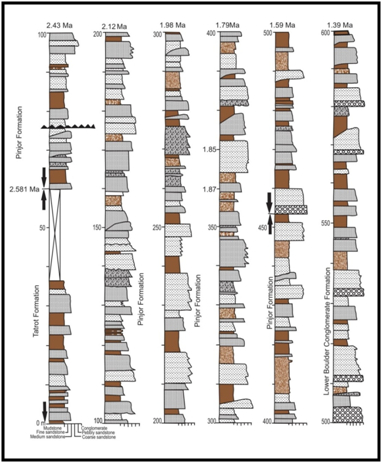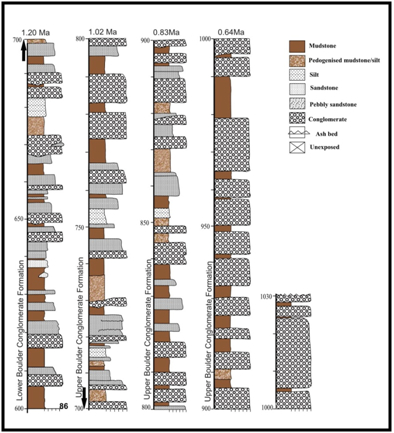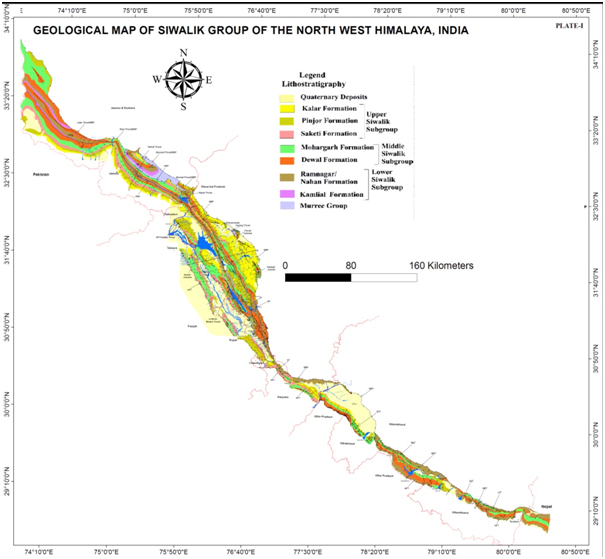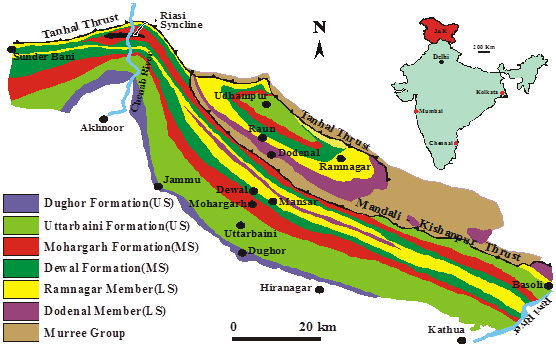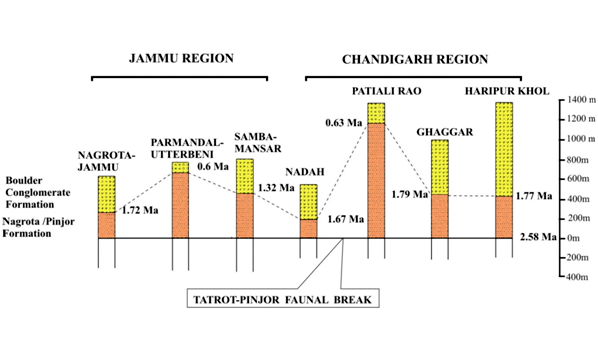Boulder Conglomerate Fm
Type Locality and Naming
Named after extensive development of Boulder Conglomerates. Type section is in Ghaggar River Section. Its thickness in type section is 575 m. [Original Publication: Pilgrim, G.E. (1910): Preliminary note on a revised classification of the Tertiary freshwater deposits of India. Records of Geological Survey of India, 40(3): 185-205; Pilgrim, G.E. (1913).Correlation of the Siwaliks with Mammal Horizons of Europe. Records of Geological Survey of India, 43 (4): 264-326; Pilgrim, G.E. (1938). Are the Equidae reliable for the correlation of the Siwaliks with the Cenozoic stages of North America? Records of the Geological Survey of India, 73(4), 437-482]. Reference section: Dughor, Jammu, its thickness is 76 m.
Synonyms: Dughor Fm in Jammu (Gupta and Verma, 1988; Gupta, 1997, 2000); Rupar IV in Masol (Ranga Rao et al., 1995); Kalar Fm in Saketi (Verma et al., 2002), India.
[Figure 1: Siwalik Type localities in Pakistan and India (source Patnaik et al., 2019)]
Lithology and Thickness
Conglomerate. The overall lithology comprises of thickly bedded massive conglomerates with pebbles, cobbles and boulders embedded in sandy to silty matrix and interstratified sandstones, and mudstones. Sandstones are mostly brown to greyish-brown in color, fine-, medium- to coarse-grained with pebbles and brown mudstones and pedogenic horizons, well-imbricated, stratified conglomerates with large-scale cross stratifications (Kumar and Tandon, 1985; Kumaravel, 2005). Its thickness is approx. 575 m.
Lithofacies: Massive, matrix supported conglomerate facies (Gms); Crudely stratified conglomerate facies (Gm);cross-stratified conglomerate facies (Gt facies);Planar cross-stratified conglomerate facies (Gp facies).Pebbly sandstone facies (St),Medium- to coarse-grained sandstone facies (St-Sp facies);Bioturbated calcareous fine-grained sandstone facies (FI facies); Parallel-laminated bioturbated mudstone facies (Fsc facies).Brown pebbly mudstone facies (Fm facies) (Kumar and Tandon, 1985).
[Figure 2: Geology of the area exposed near Chandigarh, India. The geological map is modified from Kumar and Tandon (1985)]
[Figure 3: Boulder Conglomerate Formation (Kalar Formation) exposed near Saketi, Himachal Pradesh]
[Figure 4&5: Litholog of the Upper Siwalik Subgroup exposed along the Ghaggar river (redrawn from Kumaravel et al., 2005)]
Relationships and Distribution
Lower contact
Tectonic (Thrust - Nahan Thrust) contact with the overlying Lower Siwalik.
Upper contact
Gradational contact with the underlying Pinjor Fm.
GeoJSON
Fossils
Unfossiliferous
Age
Depositional setting
The Boulder Conglomerate Formation represents the terminal phase of the deposition in the Siwalik indicative of Middle to Late Pleistocene times of the Himalayan orogeny. Proximal fan regions, debris flow at places, braided river, channel and proximal alluvial fans are common. The abundance of conglomerate deposits increases up-section within both grey and buff sandstones. Buff sandstones are more abundant than grey sandstones. Towards the top of the section conglomerate becomes matrix supported and is composed only of reworked Lower Tertiary sandstone clasts. This may indicate rapid deposition in the proximal part of the alluvial-fan debris flows (Kumar et al., 2012).
Additional Information
[Figure 8: Ghaggar River Section with paleomagnetic dates (redrawn from Kumaravel et al., 2005)]
[Figure 9: Position of the base of the Boulder Conglomerate Formation or the upper limit of the successions, in various sections of the Jammu, Chandigarh and Haripur regions. Modified after Nanda (2008). Magnetostratigraphic dates for the Jammu region are based on the work of Ranga Rao (1986), Ranga Rao et al. (1988); those of Patiali Rao, Ghaggar, Nadah, and Haripur Khol sections are after Ranga Rao et al. (1995), Kumaravel et al.(2005), Azzaroli and Napoleone (1982), and Sangode et al. (1996), respectively]
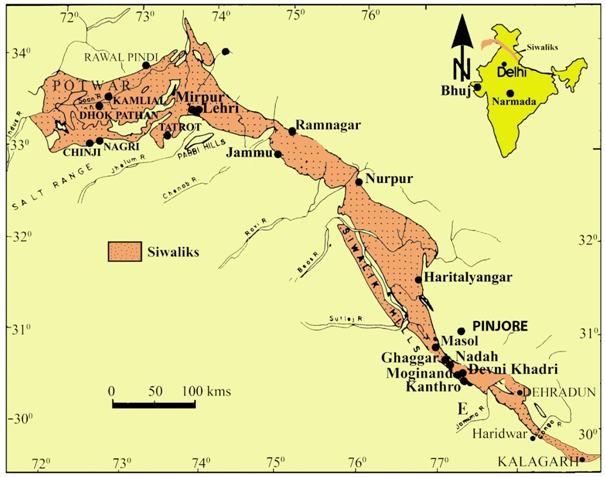
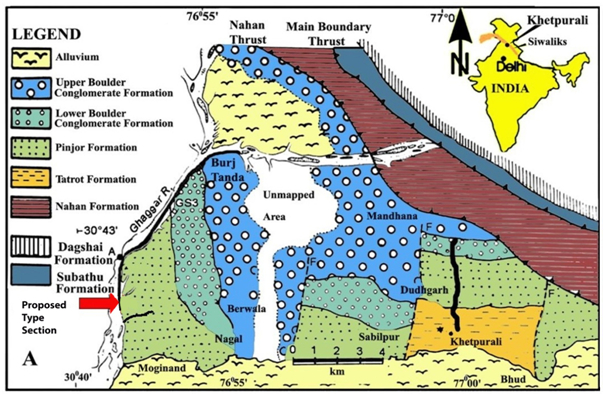
 exposed near Saketi.jpg)
